To improve economic development in Akron’s Kenmore neighborhood by supporting a strategic planning process for a pilot community development corporation.
Program Area: Community Impact
To support development and facilitation of an engagement strategy during the planning phase of an equitable digital vision and strategies for the City of Detroit and key stakeholders.
To support the City’s effort to create and implement a comprehensive economic development plan.
To support public life trainings and capacity building for San Jose’s city and civic leaders.
To improve economic development in Akron’s North Hill neighborhood by supporting a strategic planning process for a pilot community development corporation.
To support the Harvard Graduate School of Design in leading three “design studios” intended to engage Miamians in imagining how to adapt to a variety of future challenges, including affordable housing, transportation and sea level rise.
Every morning during the usually merry month of May, I received a text message from a mysterious source asking me to draw a card. After exchanging pleasantries, this entity, named The End, would provide me with a password to enter a web portal. There, I’d find a link to a video of a New Orleans funeral, say, or to a portrait gallery of adults recreating decades-old photographs taken during their youth.
Primed to muse on the special people, places and things in my life, I was ready to pursue a quest. Maybe it’d be to imagine walking through my neighborhood with a loved one who was no longer living, or perhaps to choose a song that I’d like to listen to on the last day I was alive.
I did all these things to prepare for my imminent death. Or, at least that was the gauntlet laid down by a month-long game-meets-theater multimedia production, also called “The End” and designed by Philadelphia’s Swim Pony Performing Arts. Its goal was to encourage players to move into a closer, more comfortable (indeed, comforting) relationship with the prospect of dying. When I first heard of the project my gut, well, wrenched. Because that visceral reaction seemed to be the point, I accepted the challenge.
Prepping for The End
Mention a title called “The End” to me and two completely different rock songs come to mind. The Doors’ epic is a dolorous dirge with lyrics like: “This is the end, my only friend. The end of our elaborate plans, the end of everything that stands.” The Beatles’ tune is a bright bagatelle; it reminds us that: “In the end, the love you take is equal to the love you make.”
So, how do we regard the idea of dying? As a depressing finale, or as a meaningful flourish to a life well-lived? The End, I hoped, would help steer me toward the latter.
And that’s what Adrienne Mackey, founding artistic director of Swim Pony, intended when she conceived of the project. “I began working on this about two years ago because of my own high death anxiety,” she says. “I wanted to see how I could move from a place of minimizing regret, which sounds like fear, to acceptance, which I thought would give myself permission to live life.” She started reading books like “Staring at the Sun: Overcoming the Terror of Death.” An old episode from “This American Life” called “Shoulda Been Dead,” which traced the activities of several folks who for various reasons felt they might die soon, provided insight and inspiration.
But Mackey, a director and performance instructor who has veered from traditional theater as her career progresses, also had other ideas she wanted to tackle: ideas about the state of theater today, its audiences, and how to shake things up. “For awhile now, my work has come out of a desire to keep theater relevant,” she says. “We’ve done some productions in unusual locations, we’ve done stuff that asks the audience to more directly engage with the performers.”
With the tech-based “The End”—besides texting, the project also relied on internet applications like Google Docs and Spotify—she brought the performance to the audience, using as a jumping-off point the tropes of the game world (such as tarot-like cards and quests).
“We were intrigued by the texting component because it’s how many people consume content through their mobile devices,” says Knight Foundation Program Officer Amanda Thompson. “We want to be where people are and to support artists who are interested in reaching them there,” Initially Thompson was intrigued by the audience-building potential of bringing gamers into the performing arts fold. But as time went on, she “began to see a powerful way to connect with all kinds of people who are interested in content and in particular this issue.”
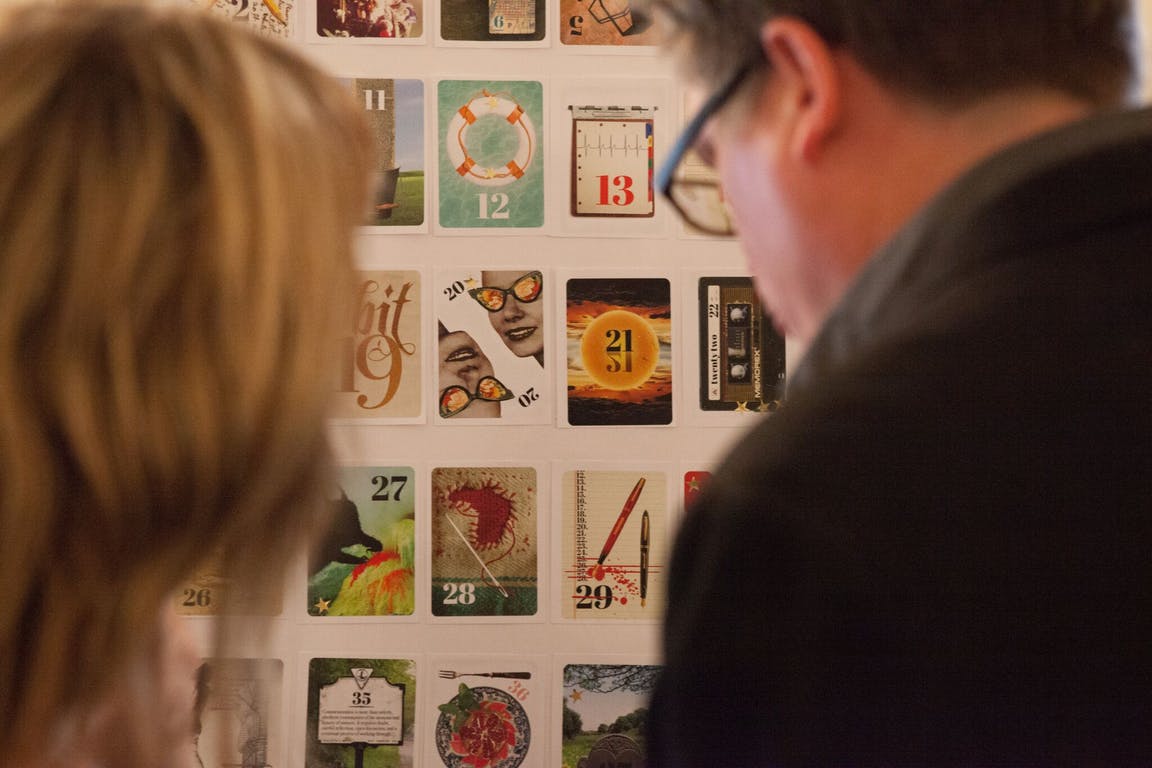
Play sends participants on a journey
Armed with a notebook and the cards, “journeyers” pursued quests as suggested by the sympathetic but elusively cool title character. Mackey formulated each quest in the same fashion: first present it within the framework of a theoretical context, and then make it real through a specific exercise to conduct or ponder upon during the day.
When I chose a card that I learned was called “you can’t take it with you,” for instance, I first read a brief passage about the sentimental value of objects. Next, I followed a link to a website about something called The Heirloom Project, then I considered my own attachment (or, really, non-attachment) to stuff and what I might like to bequeath to whom. I remembered something of my mother’s, a set of postcards from a voyage to Italy she took as a teenager during the 1940s to visit relatives.
“They’re beautiful and a treasure on their own,” I wrote to The End, “but their real significance is that they’re part of my family heritage and I have no immediate family to pass them on to.”
The End paused for a moment before responding, via text: “So it is the significance that lives in people’s memories, not the objects?”
In reality, the character of The End was embodied by seven actors who worked in tandem under the direction of Mackey. They started by greeting participants at 7:30 a.m.; when summoned, they sent journeyers off on their quests and then returned when participants were ready to reflect on those explorations. At 11:30 p.m. they signed off. Much of their texting was spontaneous, but Mackey points out that “we were careful about The End in terms of acting objectives. The End is curious about people and radically accepting, but The End has no investment other than for the player to accomplish their own goals.”
In addition to developing the lead character, Mackey researched and wrote the content for all 52 quests (one for each card), including the scripts for several guided meditations delivered via phone. Other contributors helped, of course, most visibly Maria Shaplin, the designer of the evocatively beautiful cards.
Mackey also turned to Manisha Shendge, a therapist specializing in grief and loss, for consultation on aspects of death and dying, and Emerson College’s Engagement Lab offered assistance in applying digital technology to an artistic project. In addition to receiving text messages, participants also gathered for two in-person events, including a final one at an historic cemetery.
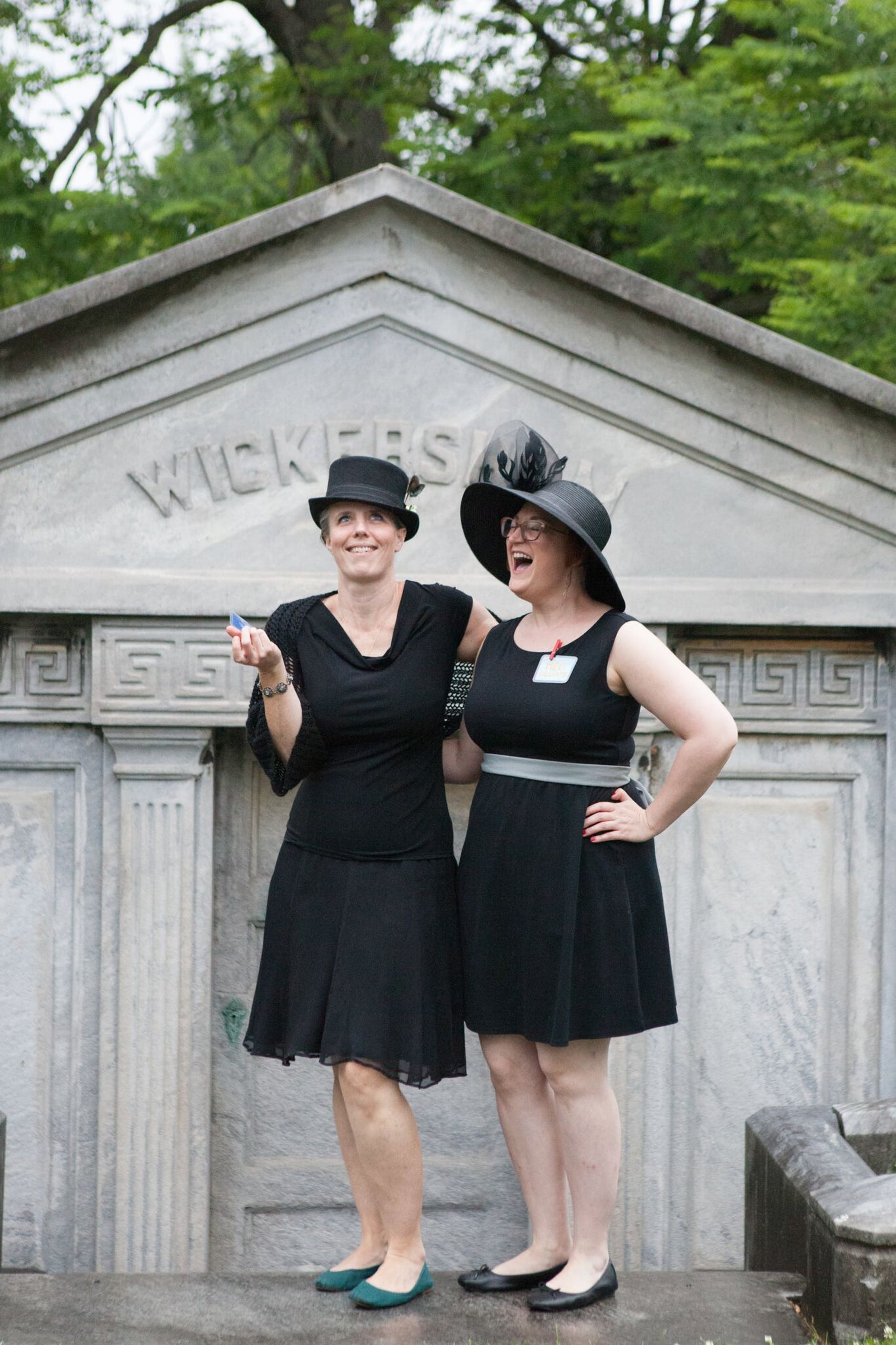
In essence, Mackey says, “The End” turns audience members into actors. “As with traditional theater, it involves witnessing an unfolding story, experiencing emotions by ruminating, and engaging in the suspension of disbelief,” Mackey observes. “But there are also strong elements of rehearsing and practicing and role-playing. Game mechanics create a structure but they also introduce variability and control. There’s an author and curated experiences, but the audience also has a voice and impact, which they don’t have in traditional theatre.” Even the character of The End remains a “kind of corpse,” until a player activates it, she says, and “never quite materializes when you try to picture a specific entity or person.”
As participants gathered at the cemetery for the final curtain—it turned out to be simply a congenial and festive party—questions about the who or what of The End seldom, er, arose. Instead, journeyers were eager to discuss their experiences questing. “For me, a lot of this had resonance because of my phase of life,” observed Ann de Forest, a 62-year-old writer. “There’s a little more of a sense of wanting to be aware of what one does going forward—and I’m also finding myself starting to deal more frequently with the mortality of others.
“I liked the one where you walked with someone who had passed away,” she continued. “I stayed with my godmother when I first moved to Philadelphia. She died when she was exactly my age; I wanted to show her around my neighborhood. The quest where you looked for signs of death as you strolled outside was also very profound for me.”
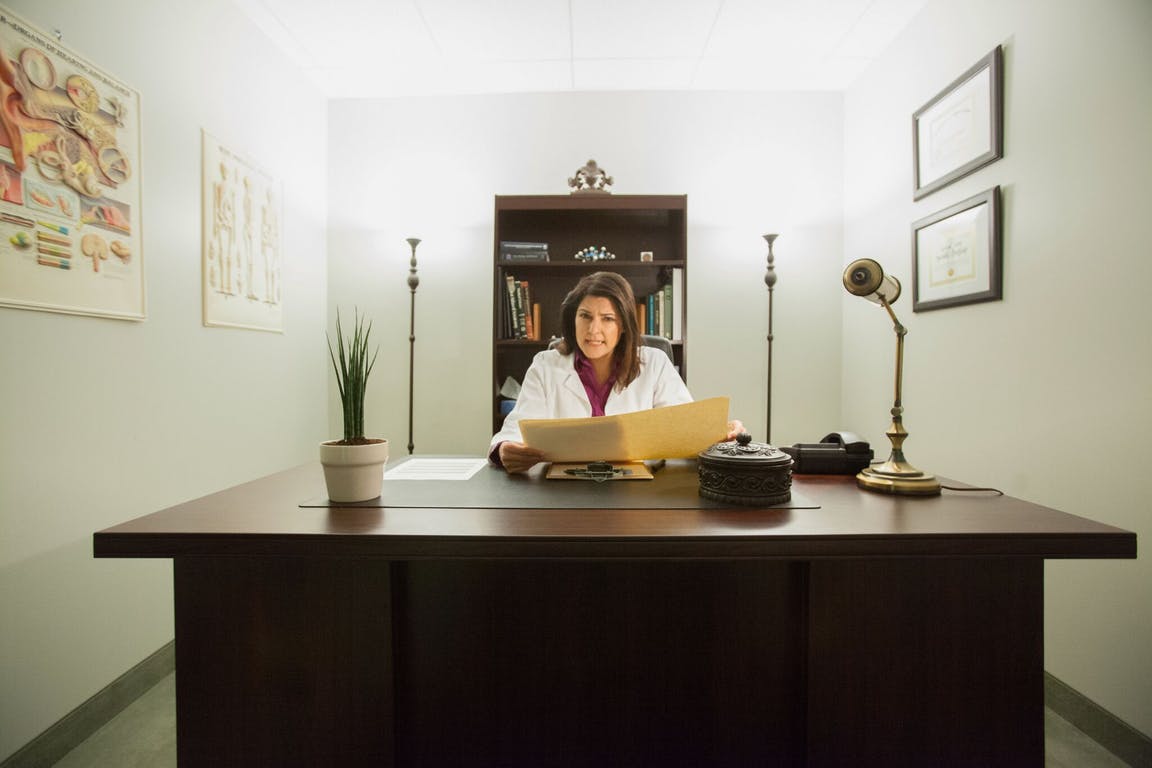
Jenny Ruymann, 24, expressed a similar appreciation for quests that got her moving. “I have a weird relation to my phone,” she said. “I feel like it keeps me from living my life. So as the game went on, I found that I wanted to be away more and I was excited to go out and do my quests.”
As did several players, Ruymann named as her favorite quest the only one that sent players to physically interact with someone else. In that quest, which marked the project’s halfway point, journeyers entered an office to meet with a “doctor” who delivered to them the news that they should begin getting their affairs in order and start saying their goodbyes—the very stuff that many of the quests had prepared them for.
A truly unforgettable 10 minutes, this experience had very little to do with the words spoken by the actor and everything to do with the theatrics. (Spoiler alert: ominous music and disorienting effects were involved.) “I was so overwhelmed that I just sat there and cried,” said Ruymann. “But then I left the building and went to meet some friends and I felt so very happy to be alive.”

Akron, Ohio—July 12, 2017—Downtown Akron Partnership today announced a project to connect Akron residents to downtown Akron through improvements to public spaces with $1.5 million from the John S. and James L. Knight Foundation. The project aligns with the city’s larger goals to build city vibrancy, encourage private investment, improve perceptions of safety and keep and attract talent.
Over the next two years, Downtown Akron Partnership will study, test and implement improvements to public space in key areas of downtown. The project builds on a “Public Space Public Life” study completed with Gehl Studio, the U.S. affiliate of Gehl Architects, a global leader in people-centered urban design. Gehl’s previous work reveals that the vibrancy of urban public spaces—greenspaces, sidewalks, streets—has a significant effect on city success. New development and retail, as well as actual and perceived safety, talent attraction and retention, sociability, walkability and property value are all affected by how public space is designed and programmed.
As part of the 18-month study, Downtown Akron Partnership worked with teams of volunteers and other groups to measure current use of public space and create prototypes to test how those spaces might be improved. Building pedestrian, cycling and social activity on city streets was further identified as a priority in both the Downtown Akron Partnership strategic plan and the Downtown Vision and Redevelopment Plan.
Based on this work, Knight Funding will focus on improving three key public spaces:
- The Link: Creating a one-mile corridor for pedestrians and cyclists that will connect The University of Akron and Akron Children’s Hospital.
- Cascade Plaza: Enhancing a key public park adjacent to new residential development.
- Night Out at North High Street: Improving and activating the sidewalks around the North High business district to attract new activity and pedestrian traffic to the area.
In addition, Downtown Akron Partnership will work to scale up the current clean and safe services provided by Downtown Ambassadors, and expand the startup rent subsidy for new downtown retail businesses including the Northside Marketplace, while providing for marketing Akron’s downtown.
“In every study and stakeholder focus group that Downtown Akron Partnership has convened, participated in or assisted with over the last three years, we have heard a resounding desire to continue to improve downtown’s vibrancy with more people, more consistently in more places,” said Suzie Graham, Downtown Akron Partnership president and CEO. “This project moves us toward that goal, recognizing that public space has a leading role to play, as we continue the work to secure more jobs, increase housing options, connect employees to downtown activities, and improve infrastructure.”
“As Akron aims to create more opportunities to keep talent in the city and attract new investment, we must make it more of a city where people want to live, work and build their lives,” said Kyle Kutuchief, Knight Foundation program director for Akron. “Creating public spaces that improve downtown life and motivate people to explore and connect with their city is essential to Akron’s future success.”
The previous Gehl work included a survey of public spaces and public life, and helped define the current state of activity in Akron’s public spaces. The study sets the groundwork for devising a strategy to better connect Akron residents to downtown.
Support for Downtown Akron Partnership comprises part of Knight Foundation’s efforts in Akron to attract and keep talented people, expand economic opportunity and create a culture of engagement. Since 2008 Knight has invested more than $58 million in Akron.
About Downtown Akron Partnership
The mission of Downtown Akron Partnership (DAP) is to promote and build a vibrant and valuable downtown. DAP is a nonprofit organization dedicated to bringing people, activity, business and a thriving civic life to the heart of Akron. Through strategic marketing, clean and safe programs and management of downtown’s resources, DAP works to promote downtown as a gathering place in the center of our community.
DAP’s members include property owners, business leaders and government officials who want to improve the image of downtown as a safe, convenient location for businesses, working professionals and families. DAP is governed by a board of trustees as diverse as the interests of our city. DAP is supported by the John S. and James L. Knight Foundation, Akron Community Foundation and GAR Foundation.
About the John S. and James L. Knight Foundation
Knight Foundation is a national foundation with strong local roots. We invest in journalism, in the arts, and in the success of cities where brothers John S. and James L. Knight once published newspapers. Our goal is to foster informed and engaged communities, which we believe are essential for a healthy democracy.
CONTACTS:
Sharon Gillberg, Communications Director, Downtown Akron Partnership, 330-374-7676, [email protected].
Anusha Alikhan, Director of Communications, Knight Foundation, 305-908-2646, [email protected]
Suzie Graham is president of Downtown Akron Partnership, a nonprofit organization that builds and promotes the vibrancy and value of downtown Akron. Below, she writes about undertaking focused public space improvements in the downtown to improve neighborhood life. Downtown Akron Partnership is receiving $1.5 million in new support from Knight Foundation.
Visualize a vibrant city. Several features typically come to mind: authentic architecture, distinctive destinations, inviting green spaces, delicious and diverse food, intriguing art, a variety of transportation options and one critical and consistent element— ever-present people. The ways that people interact with a place, and with other people in that place, define the character and quality of a city.
Akron has a right-sized amount of all the makings of a vibrant city. Our eclectic blend of architecture includes historic buildings, a Masonic Temple, an atmospheric theatre and the first public building in the United States designed by internationally acclaimed design firm Coop Himmelb(l)au. The city is also anchored by the University of Akron and major corporations, and boasts a multitude of independent restaurants, high quality green spaces, local and international public art, a Leadership in Energy and Environmental Design-certified transit center, a minor league ball park, a national park and a host of charming small businesses. These are all set against a backdrop of canal spillways and passing trains, signaling the city’s rich history as a major U.S. transportation hub and meeting place.
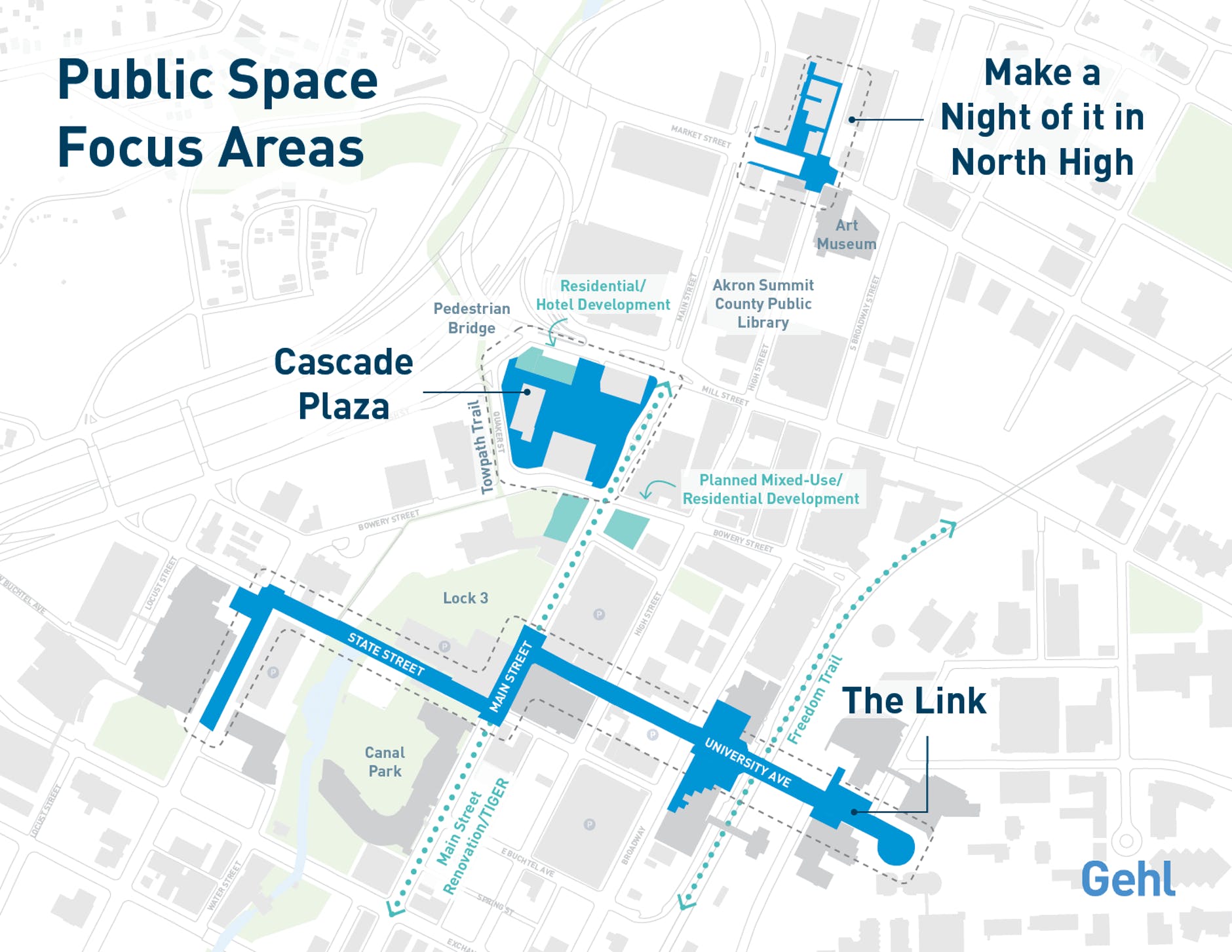
Despite these amazing and much-loved amenities, plus 23,000 students, 47,500 employees and 3.7 million annual visitors, it doesn’t often look like there are lots of people in the city. With the help of Gehl Studio, the U.S. affiliate of Gehl Architects, a global leader in people-centered urban design, the Downtown Akron Partnership set out to find out why. Over the last 18 months, Gehl Studio led Downtown Akron Partnership and a team of volunteers through a study and a series of prototype projects to measure downtown Akron’s public spaces, neighborhood life and the potential to improve both. The study found that to bring more vibrancy to the city, we need to strengthen resident connections with downtown and create more opportunities for people to enjoy it. The best way to make this happen is through our public spaces.
Improvements to public space have a broad effect on overall city success. Business attraction, private investment, perceived and actual safety, talent retention and attraction, greater connection to place and walkability are all influenced by the way we set the table for human interaction in public spaces. Our streets, sidewalks, street furniture and environment influence how long we stay, how we socialize and how we feel about a place.
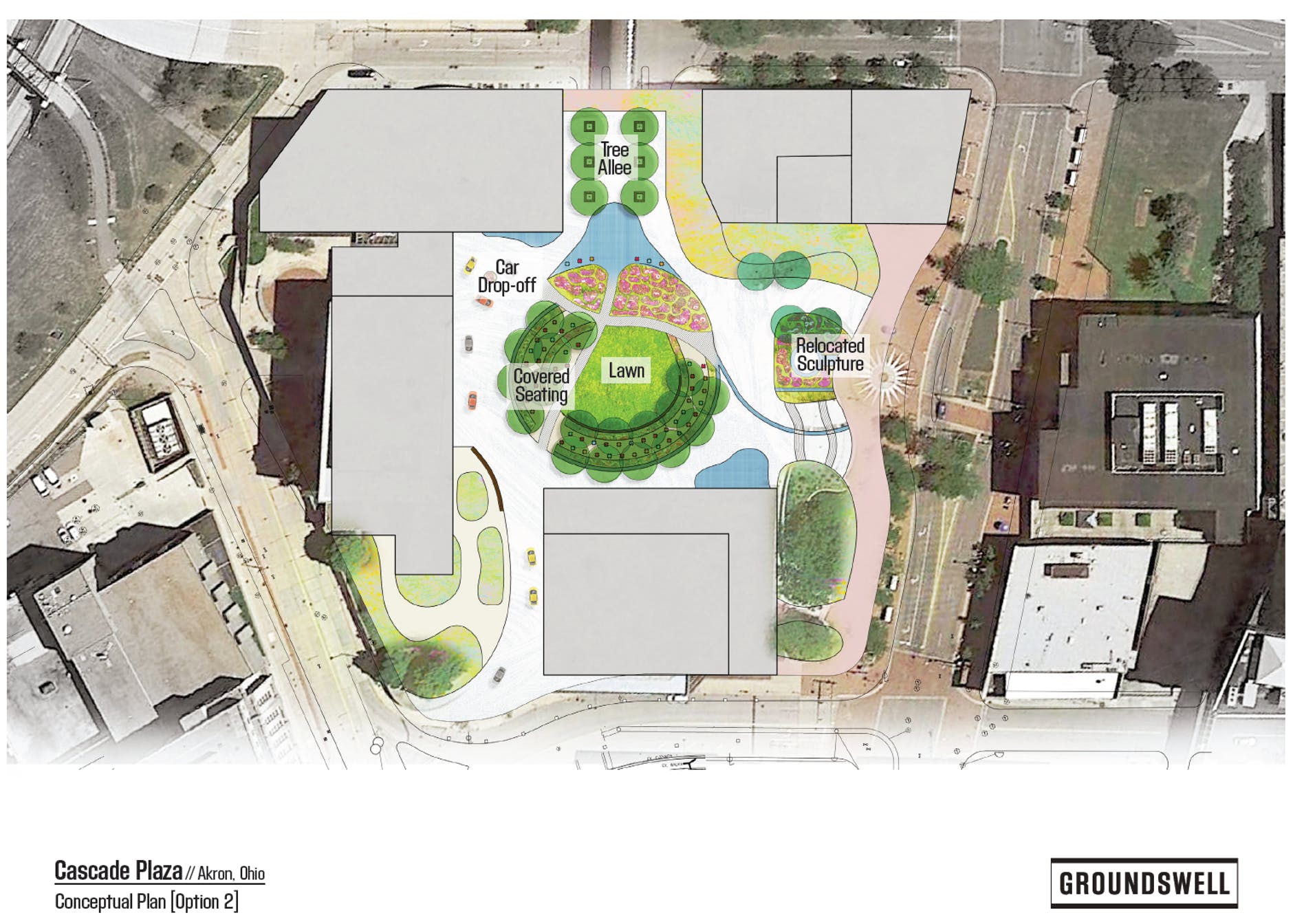
With this in mind, and building on the work we’ve done with Gehl, Downtown Akron Partnership is now embarking on a plan to improve key public spaces in Akron, with the goals of increasing foot traffic, diversifying activities in our public spaces, building connections to downtown among people and students, improving environmental design and spurring private investment. The efforts will be shaped by insights and inspiration from Gehl Studio, Better Block and Groundswell Design Group, while taking cues from the city’s Downtown Vision and Redevelopment Plan and enhancing public and private development already in progress.
This new support from Knight Foundation will also allow Downtown Akron Partnership to build capacity. In alignment with Gehl practices and the Knight-supported national Reimagining the Civic Commons initiative, improvements will include designing with people who currently use and invest in the space, gathering community feedback through a series of “test and learn” demonstration projects, and an impact analysis.
Jan Gehl, founding partner of Gehl Architects, is known for quoting a 1,000-year-old poem by Hávamál who said: “Man is man’s greatest joy.” In this spirit, we hope to build an Akron with people and for people in the hopes that they will love its public places, enjoy connecting with each other and know the city as their own.
-
Community Impact / Press Release
To sustain the existing momentum that Cycles for Change has achieved with the initial investments from Knight Foundation. This grant will continue to build upon the groundwork that was laid in the 2016 launch of Slow Roll St. Paul, which builds healthy, vibrant, and equitable communities through slow rolling, no-drop bike rides.
To provide a free two-day civic hack-a-thon in downtown Saint Paul, where technologists, entrepreneurs, artists, educators, data scientists, concerned residents, and everyday people harness inclusion, data, and technology, empowering people to solve problems for their own communities in new ways, taking place September 23 and 24, 2017.